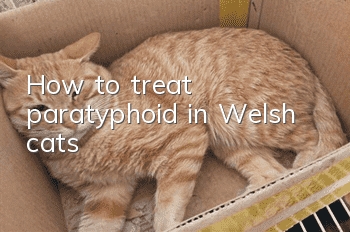How to treat paratyphoid in Welsh cats?

How to treat paratyphoid in Welsh cats? Paratyphoid is also known as salmonellosis. Clinically, it usually manifests as sepsis and enteritis. It is mainly an infectious disease in young cats. So, once our cat suffers from this disease, how should we prevent and treat it?
1. Occurrence and spread
The causative agent of this disease is Salmonella. The milk, meat, and eggs produced by animals suffering from this disease may contain this bacteria. The feces of sick animals also contain a large amount of Salmonella. Therefore, when healthy cats come into contact with contaminated food, water, etc., or when cats are fed these foods without boiling, they can become infected through the digestive tract. In addition, cages, utensils, etc. contaminated by pathogens also play a certain role in the spread of the disease. The sick cat has a history of contact with or eating contaminated items or food.
2. Symptoms
Clinically, sick cats can be seen with elevated body temperature, depression, reduced appetite or no eating, shallow breathing, vomiting and diarrhea, watery or mucus-like feces, and blood in loose stools in severe cases. The whole body is weak, often lying down, rapid weight loss, severe diarrhea, pale mucous membranes, weakness, dehydration, and jaundice before death. After the kitten is infected, the body temperature drops, the body is obviously weak, and signs of metastasis often appear. The mortality rate of cat salmonellosis is about 10%, and it can significantly affect the growth and development of cats. Based on the above symptoms, generally only a preliminary diagnosis can be made, and the final diagnosis must rely on laboratory testing.
3. Prevention and Control Measures
Strengthen feeding and management, prohibit feeding bacteria-carrying or infected fish, meat, milk and dairy products, and strictly control sick cats; sick cats should be in contact with healthy cats. Sick cat houses, cat litters, food utensils and other utensils should be disinfected with Lysol, chlormethionine, 5% ammonia, and 3% caustic soda solution. The body was to be buried deeply or burned. Sick cats can be treated with antibiotics. Commonly used: chloramphenicol is injected subcutaneously or intramuscularly, the dosage is 20 mg per kilogram of body weight, once a day, for 3-5 days, or oral administration of neomycin tablets, the dosage is 5-10 mg per kilogram of body weight, once a day, continuously for 5 days -7 days, or oral administration of furazolidone (furatolin), the daily dosage is 10 mg, 1000 grams of body weight, taken orally in two times, for 5-7 days. Garlic paste can also be taken orally. Take 5-25 grams of garlic and pound it into garlic paste, or make garlic anhydride and take it orally three times a day for 3-4 days. Symptomatic treatment, such as infusion, heart protection, intestinal fermentation, protection of gastrointestinal mucosa, etc.
- How long does it take for a newly arrived cat to adapt?
- Why is dry cat food not suitable as a cat’s staple food?
- Can cats eat Xuelihong?
- Feline Herpes Virus Symptoms and Treatment
- How long does a cat live? How many years do cats generally live?
- What does a cat imply when it frequently steps on its milk?
- How to prevent and treat fleas in cats
- What should you pay attention to when raising cats and dogs together?
- Is it easy to raise a gradually folded cat?
- Does a tortoiseshell cat recognize its owner?



